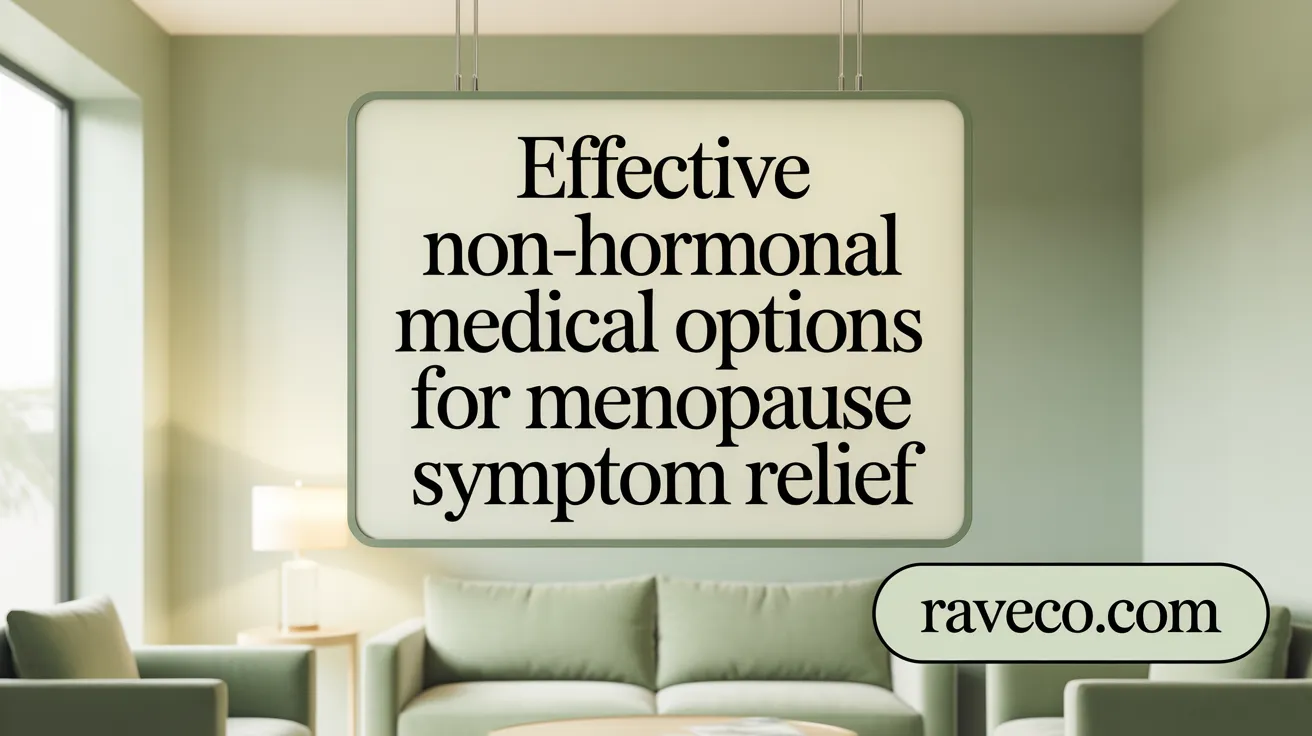Bridging Genetics and Prenatal Care: Empowering Women Through Counseling and Screening

Understanding Menopause and Its Impact
Menopause marks a significant biological transition in a woman's life, typically occurring around the age of 51, characterized by the cessation of menstrual periods for 12 consecutive months and a decline in estrogen and progesterone production. This transition, including perimenopause, menopause, and postmenopause stages, brings a wide range of symptoms such as hot flashes, night sweats, vaginal dryness, mood changes, sleep disturbances, and increased risks for osteoporosis and cardiovascular disease. Understanding the diagnosis, treatment options, and effective self-care strategies is essential for women to navigate menopause confidently and maintain their quality of life.
Diagnosing Menopause: Symptom-Based and Laboratory Assessments
How is menopause diagnosed?
Menopause diagnosis mainly relies on clinical symptoms. Women usually recognize menopause by experiencing key signs like irregular periods and hot flashes. The official confirmation of menopause occurs after 12 consecutive months without menstruation, marking the end of reproductive cycles.
What is the role and limitations of blood tests?
Blood tests measuring follicle-stimulating hormone (FSH), estrogen, and thyroid-stimulating hormone (TSH) can support the diagnosis. However, hormone levels frequently fluctuate during perimenopause, making these tests often inconclusive and not definitive for diagnosis. Consequently, blood tests are supplementary rather than essential.
Why is symptom tracking important?
Tracking symptoms carefully allows for a clearer picture of menstrual irregularities and menopausal changes over time. Women are encouraged to note patterns in hot flashes, mood swings, and bleeding to help healthcare providers assess their stage of menopause accurately.
When should women consult healthcare providers?
Consulting a healthcare professional is recommended particularly if symptoms become severe, bleeding is irregular or prolonged, or there is uncertainty about menopausal status. Professional assessment ensures personalized guidance and the consideration of other conditions that may mimic menopause. For more information, see Consulting healthcare professionals.
By combining symptom awareness with medical evaluation, women can receive accurate diagnosis and tailored management of menopause.
Hormone Therapy: The Cornerstone of Menopause Medical Treatment

Types of Hormone Therapy
Hormone therapy (HT) for menopause primarily comprises two types:
- Estrogen-only therapy: Recommended for women who have had a hysterectomy since estrogen alone does not increase the risk of uterine cancer (Hormone Replacement Therapy for Menopause - Cleveland Clinic, Hormone therapy for menopause - ACOG).
- Combined estrogen-progestin therapy: Prescribed for women with an intact uterus to prevent endometrial hyperplasia and cancer caused by unopposed estrogen (Menopause diagnosis - Mayo Clinic, Hormone Replacement Therapy for Menopause - Cleveland Clinic).
Indications and Contraindications
HT is highly effective for treating menopausal symptoms such as hot flashes, night sweats, vaginal dryness, mood swings, and for preventing osteoporosis. However, it is not suitable for women with a history of breast, ovarian, or uterine cancer, blood clots, stroke, heart disease, liver disease, or abnormal vaginal bleeding (Menopause medicines help you - FDA, Hormone therapy for menopause - ACOG.
Benefits
Hormone therapy provides:
- Rapid relief from vasomotor symptoms (hot flashes and night sweats) (Hormone therapy benefits - NHS, Hormone Replacement Therapy Benefits - Cleveland Clinic.
- Improvement in vaginal dryness and discomfort (Vaginal estrogen treatment - Mayo Clinic, Menopause and vaginal dryness management - Mount Sinai).
- Prevention and treatment of bone loss, reducing osteoporosis and fracture risk (Osteoporosis prevention - Mayo Clinic, Vitamin D supplements - NHS).
- Positive effects on mood and sleep quality (Hormone therapy benefits on mood and sleep - NHS, Caring for Yourself During Menopause - Weill Cornell).
Risks and Side Effects
Though generally safe when used appropriately, HT carries some risks such as:
- Increased chances of blood clots and stroke, particularly with oral estrogen (Hormone therapy risks - Mayo Clinic, Risks of Hormone Replacement Therapy - Cleveland Clinic.
- Slightly higher risk of breast and uterine cancers; progestin reduces uterine cancer risk (Hormone therapy for menopause - FDA, Hormone Therapy Risks & Benefits - NHS).
- Gallbladder disease (Hormone Therapy Risks - Mayo Clinic).
- Side effects including breast tenderness, headache, bloating, and irregular vaginal bleeding (Hormone Therapy Side Effects - Cleveland Clinic.
These risks are minimized when therapy is started before age 60 or within 10 years of menopause onset, using the lowest effective dose for the shortest duration necessary (Hormone Replacement Therapy Guidelines - Mayo Clinic.
Importance of Progestin with an Intact Uterus
Adding progestin to estrogen therapy in women with a uterus is crucial to protect the uterine lining from hyperplasia and cancer. Progestin can be administered orally, via patches, or intrauterine devices (Hormone Therapy for Menopause - NHS, Hormone therapy for menopause - Mayo Clinic).
Routes of Administration
HT can be delivered through:
- Oral tablets.
- Transdermal patches and gels (bypass liver metabolism, potentially lower risk of blood clots).
- Vaginal tablets, creams, or rings (primarily for local symptoms like vaginal dryness) (Hormone Replacement Therapy Forms - NHS, Menopause vaginal treatments - Mayo Clinic.
Treatment Duration and Monitoring
Treatment duration is individualized, often recommended for around five years or less. Regular follow-ups assess symptom relief, side effects, and changing health risks. Dose adjustments may be needed to balance benefits and potential adverse effects (Hormone Therapy Monitoring - Mayo Clinic, Menopause treatment follow-up - NHS.
In summary, hormone therapy remains the most effective medical treatment for managing menopausal symptoms and protecting bone health when carefully tailored and monitored (Hormone Therapy Overview - Mayo Clinic, Hormone Therapy for Menopause - Cleveland Clinic.
Non-Hormonal Medical Options for Symptom Relief

What are the alternatives to hormone therapy for managing menopause symptoms?
For women who cannot or prefer not to use hormone therapy for menopause, several effective non-hormonal treatments for menopause medical options are available to manage menopausal symptoms.
Antidepressants for Hot Flashes
Selective serotonin reuptake inhibitors (SSRIs and serotonin-norepinephrine reuptake inhibitors (SNRIs are commonly prescribed to reduce hot flashes and help with mood symptoms often experienced during menopause.
Gabapentin and Clonidine
Gabapentin, originally used for nerve pain, and clonidine, a blood pressure medication, also relieve vasomotor symptoms like hot flashes. Their effectiveness varies, and they may have side effects such as dizziness or fatigue.
Fezolinetant
An FDA-approved, non-hormonal drug called fezolinetant works by targeting brain pathways that regulate body temperature, offering relief from hot flashes without hormones. Common side effects may include abdominal discomfort or sleep disturbances.
Treating Vaginal Dryness
Vaginal dryness and pain during intercourse can be eased using prasterone (DHEA) vaginal inserts, as well as over-the-counter lubricants and vaginal moisturizers that help maintain tissue hydration.
Osteoporosis Medications and Supplements
To protect bone health post-menopause, medications like bisphosphonates may be prescribed. Additionally, vitamin D and calcium supplements support bone density and reduce fracture risk.
These non-hormonal options provide important alternatives for symptom relief, improving quality of life for women who cannot or choose not to use hormone therapies.
Lifestyle Modifications and Self-Care Strategies to Manage Menopause

What self-care strategies help manage menopause symptoms?
Managing menopause involves various lifestyle and self-care approaches that can significantly ease symptoms and improve quality of life.
Dressing in layers and keeping living spaces cool help manage hot flashes and sudden heat sensations common during menopause. Wearing breathable fabrics like cotton or linen enhances comfort.
Diet plays a vital role; consuming calcium-rich foods such as milk, yogurt, and kale supports bone health, while vitamin D—achieved through sunlight and supplements—promotes calcium absorption and osteoporosis prevention. A balanced, nutritious diet also assists in maintaining healthy weight, which can lessen the impact of symptoms.
Regular physical activity, especially weight-bearing and resistance exercises like walking, running, and strength training, strengthens bones, aids mood regulation, and supports cardiovascular health. Exercise also helps manage weight gain often experienced during menopause. See more about exercise benefits during menopause.
Sleep disturbances can be addressed through good sleep hygiene practices and relaxation techniques. These include maintaining consistent sleep schedules, practicing yoga, meditation, and learning cognitive behavioral therapy (CBT) to manage mood swings and anxiety.
Avoiding smoking and limiting alcohol consumption reduces symptom severity and lowers risks for heart disease and osteoporosis. See lifestyle changes for menopause for more details.
Finally, pelvic floor exercises improve urinary symptoms and enhance sexual health by strengthening pelvic muscles. Learn more about urinary symptom management during menopause.
Together, these self-care strategies provide an effective, holistic approach to managing menopausal symptoms.
Addressing Vaginal and Sexual Health During Menopause

How can vaginal dryness and sexual health issues be managed during menopause?
Vaginal dryness and discomfort during intercourse are common issues during menopause caused by decreased estrogen levels. One effective approach is the use of local estrogen therapies, including vaginal creams, tablets, and rings, which deliver estrogen directly to vaginal tissues. These treatments reduce dryness, pain during sex, and urinary symptoms with minimal systemic hormone exposure.
In addition to estrogen, over-the-counter vaginal lubricants and moisturizers provide quick and accessible relief from dryness. Water-soluble lubricants are preferred especially for use with condoms to avoid damage. Vaginal prasterone (a form of DHEA) inserts can also be prescribed to improve vaginal health and reduce pain (Prasterone for vaginal dryness.
Sexual health changes such as reduced libido or difficulty with arousal are common. Open communication with partners and healthcare providers is important for managing these changes. Continued sexual activity, if desired, can be supported by these treatments and contributes positively to emotional well-being and relationship satisfaction (Caring for yourself during menopause.
By combining medical treatments and self-care strategies, menopausal women can maintain comfort and intimacy during this life stage.
Complementary and Alternative Therapies: Benefits and Cautions

What is the role of alternative therapies in managing menopause symptoms?
Complementary and alternative therapies are frequently explored by women to alleviate menopausal symptoms.
Phytoestrogens, naturally occurring in foods like soy and flaxseed, may modestly reduce hot flashes and contribute to hormone balance.
Herbal supplements such as black cohosh have shown mixed results, with some studies indicating mild benefits for hot flashes but overall inconsistent evidence.
Mind-body therapies including cognitive behavioral therapy (CBT) have demonstrated effectiveness in managing mood swings, anxiety, and sleep difficulties that often accompany menopause.
Other practices like acupuncture, yoga, and hypnosis are also used to promote relaxation and reduce symptom distress, although scientific support varies.
However, the safety and effectiveness of many of these alternative treatments are not fully established.
Herbal supplements may interact with medications or cause side effects, and compounded bioidentical hormones lack FDA regulation, raising concerns about quality and safety.
Given these uncertainties, it is vital for women to consult healthcare providers before starting any complementary or alternative therapies.
Professional guidance ensures safe integration with other treatments and helps prevent potential risks associated with unmonitored use.
Empowerment, Education, and Support for Women During Menopause
How can women be empowered and supported during menopause?
Empowering women through comprehensive health education is essential during menopause. Educational initiatives that focus on physical activity, balanced nutrition, and effective stress management equip women with the necessary tools to understand and manage their symptoms better. These programs raise awareness about menopause, promoting healthier attitudes and enhancing coping skills.
Support groups and community networks play a crucial role in offering emotional support and shared experiences. They help women feel less isolated and more understood during this transitional phase. Such social support encourages positive attitudes and improves overall wellbeing (Caring for Yourself During Menopause.
Access to specialized healthcare professionals trained in menopause care is increasingly important. These experts provide personalized evaluations, tailored therapies, and guidance, ensuring that treatment plans align with each woman's unique health needs (Consulting healthcare professionals.
Preparation for medical consultations enhances the quality of care. Women are advised to keep track of symptoms, maintain a detailed list of medications and supplements, and prepare specific questions. This proactive approach allows healthcare providers to make more accurate diagnoses and develop effective management strategies.
Cultural sensitivity and customization of care further empower women by respecting individual backgrounds and preferences, making the menopause journey more manageable and confident.
Integrating Medical Treatments and Self-Care for Optimal Menopause Support
Menopause is a natural yet complex transition that impacts women physically, emotionally, and socially. A comprehensive approach combining evidence-based medical treatments, including hormone therapy and non-hormonal medications, with lifestyle modifications and self-care strategies, offers the best outcomes. Addressing symptoms such as hot flashes, vaginal dryness, mood changes, and bone health requires personalized plans informed by thorough diagnosis and ongoing medical consultation. Complementary therapies may offer additional relief but should be used cautiously under medical guidance. Empowering women through education, support networks, and specialized care fosters improved quality of life and resilience during menopause and beyond.





.png)